

Vivienne Westwood talks eco friendly fashion. Wearable pineapple fibres could prove sustainable alternative to leather. At weddings and formal events in the Philippines, men can often be seen wearing the Barong Tagalog, a thin and transparent embroidered garment worn over a shirt.

One of the more surprising materials used in its manufacture are fibres from pineapple leaves – and long strands of the leaves could soon also be used to make a host of other products, from trainers and clothes to bags and car upholstery. Called Piñatex - piña is Spanish for pineapple - the new material was created by Carmen Hijosa, who worked as a consultant in the Philippines leather goods industry in the 1990s. Where do your old clothes go? 11 February 2015Last updated at 10:01 ET By Lucy Rodgers BBC News Every year, thousands of us across the UK donate our used clothing to charity - many in the belief that it will be given to those in need or sold in High Street charity shops to raise funds.

TED's Ten « Textiles Environment Design. The TEN → sign up.
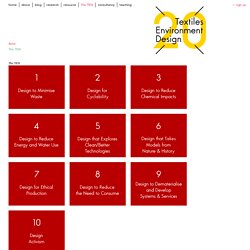
FASHION & SUSTAINABILITY, Sass Brown. Sewrendipity. Hi, I’m Alex and about 6 years ago I knew absolutely nothing about sewing.
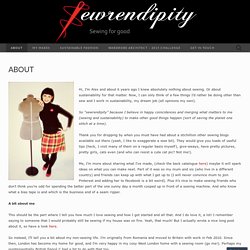
Or about sustainability for that matter. Now, I can only think of a few things I’d rather be doing other than sew and I work in sustainability, my dream job (all opinions my own). So “sewrendipity” because I believe in happy coincidences and merging what matters to me (sewing and sustainability) to make other good things happen (sort of saving the planet one stitch at a time).
Thank you for dropping by when you must have had about a stichillion other sewing blogs available out there (yeah, I like to exaggerate a wee bit). They would give you loads of useful tips (heck, I visit many of them on a regular basis myself), give-aways, have pretty pictures, pretty girls, cats even (and who can resist a cute cat pic? Me, I’m more about sharing what I’ve made, (check the back catalogue here) maybe it will spark ideas on what you can make next. A bit about me So instead, I’ll tell you a bit about my non-sewing life. Green Fashion: 7 Reasons Why You Should Care About Sustainable Fashion. Photo via staralee @ flickr The fashion industry loves to tell you what you absolutely have to do: wear this top, buy those pants, pair that dress with those boots, carry that bag.
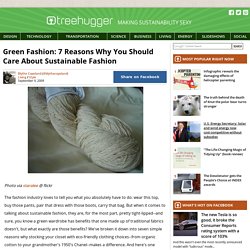
But when it comes to talking about sustainable fashion, they are, for the most part, pretty tight-lipped--and sure, you know a green wardrobe has benefits that one made up of traditional fabrics doesn't, but what exactly are those benefits? We've broken it down into seven simple reasons why stocking your closet with eco-friendly clothing choices--from organic cotton to your grandmother's 1950's Chanel--makes a difference. Eco-Tip: Mini Directory of Green Fabrics. We are often asked by readers where to find suppliers of particular eco-materials, so they might join the fray and green their own product.
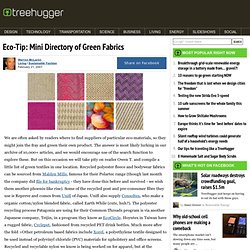
The answer is most likely lurking in our archive of 10,000+ articles, and we would encourage use of the search function to explore these. But on this occasion we will take pity on reader Owen T. and compile a little list of green textiles in one location. Recycled polyester fleece and bodywear fabrics can be sourced from Malden Mills, famous for their Polartec range (though last month the company did file for bankruptcy - they have done this before and survived - we wish them another phoenix-like rise).
Sustainable material pioneers: what does the future hold? What’s wrong with the materials I’m wearing now?
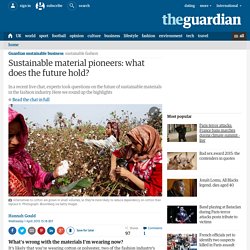
It’s likely that you’re wearing cotton or polyester, two of the fashion industry’s most popular fibres. Cotton depends on large amounts of water to grow, and polyester depends on now-declining reserves of oil and gas. The idea behind sustainable materials is that they are less damaging to the environment to produce, consuming fewer natural resources and creating less pollution. Erin Smith, artist in residence at Microsoft Research explains: We are living in a time when our growing population and consumption habits are no longer going to be supportable at our present escalating rate.
Can big brands catch up on sustainable fashion? Imagine a pair of trousers you could throw on the compost.

After years of use, they could decompose among the eggshells and tea bags to leave behind nothing but some fertile soil to help grow new raw materials. It takes the circular economy to a whole new level. This is the idea behind F-ABRIC, a range of materials developed by Swiss company Freitag. Until recently, Freitag’s only line of business was making bags out of old truck tarpaulins. While natural fibres like cotton will compost over time, synthetic fibres like polyester won’t, and natural fibres are often blended with synthetic. The fact that it is biodegradable does not make the fabric any less hard-wearing, says one of the founders, Daniel Freitag. Freitag is not the only company looking to microorganisms for inspiration.